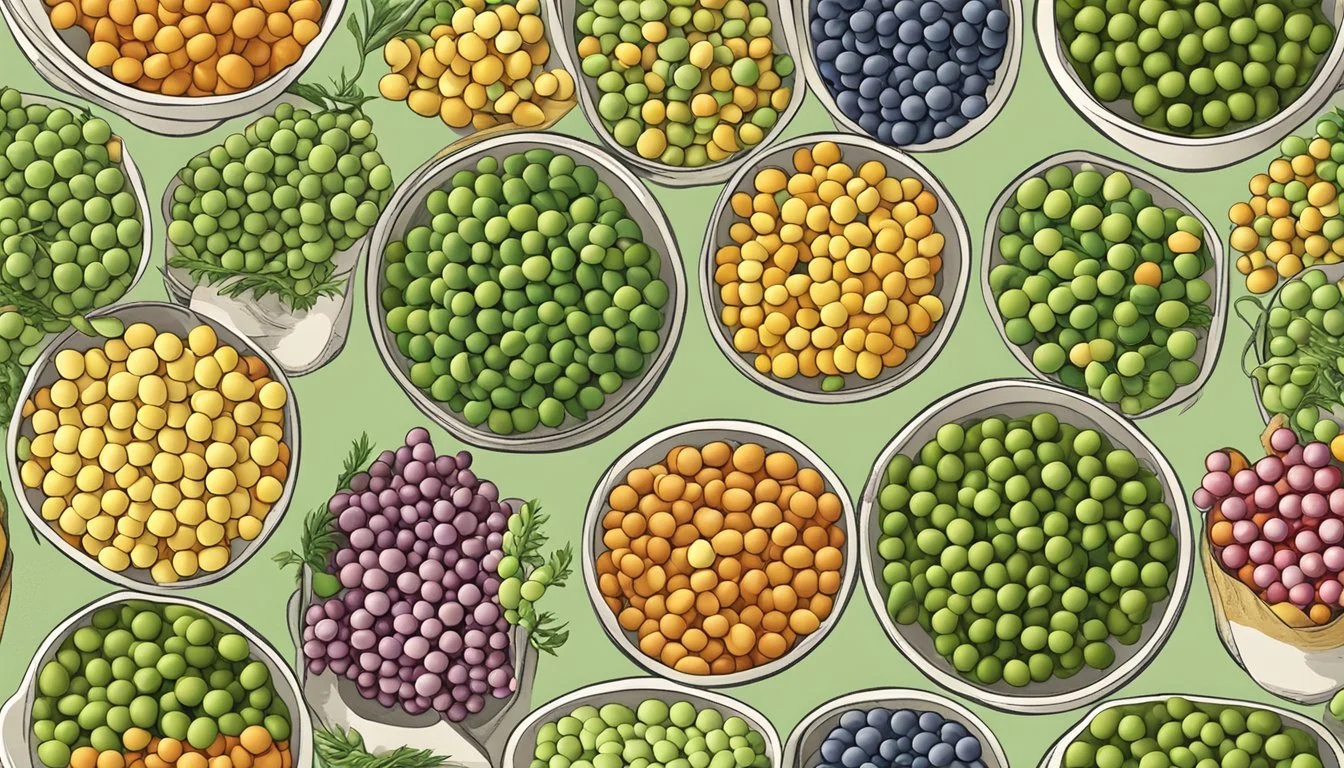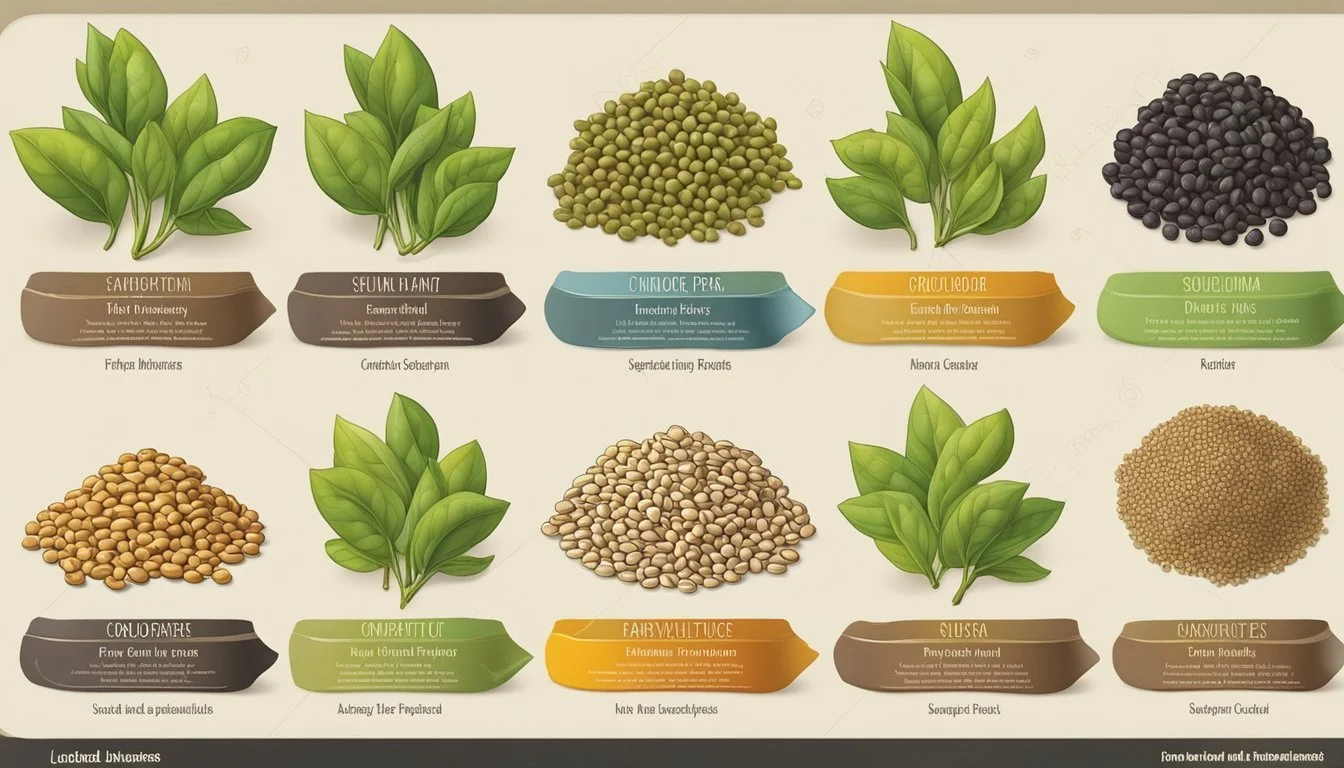Crowder Peas Substitutes
Best Alternatives for Cooking
Crowder peas, with their rich nutrient profile and distinctive flavor, are a staple in Southern cuisine. They are known for their creamy texture and are often used in various dishes like soups, stews, and salads. For those looking to find substitutes for Crowder peas, there are several viable options that can match their nutritional value and taste.
Lentil beans, for instance, offer a hearty alternative, though they require a longer cooking time to achieve the desired softness. Fresh lima beans, another great substitute, bring a similar nutty and sweet taste that integrates well with other ingredients without overpowering them. Cranberry beans and Borlotti beans can also serve as suitable replacements, both providing a unique flavor profile that complements a range of dishes.
Lastly, Kentucky Wonder Beans and Southern Pink Lady Peas can be excellent substitutes. These beans share a similar texture and nutritional benefits, making them perfect for recipes that require the same creamy consistency and rich taste as Crowder peas. Experimenting with these substitutes can ensure that the essence of your dishes remains intact, even when Crowder peas are not available.
Understanding Crowder Peas
Crowder peas, a type of southern pea, are known for their rich flavor and adaptability in a variety of dishes. This section explores their types, nutritional benefits, and uses in cooking.
Typography and Varieties
Crowder peas fall under the cowpea category and are often confused with black-eyed peas due to their similar appearance. Varieties include purple hull peas, southern pink lady peas, and pinkeye purple hull peas.
Purple Hull Peas: Recognizable by their purple pods and creamy texture.
Southern Pink Lady Peas: Noted for their delicate flavor and light color.
Pinkeye Purple Hull Peas: Feature a distinct pink eye and robust taste.
These varieties add diversity to southern cuisine, making them a staple in many traditional recipes.
Nutritional Profile
Crowder peas offer a powerhouse of nutrients. They are a good source of fiber, providing digestive benefits and aiding in maintaining blood sugar levels. Rich in protein, they support muscle growth and repair.
They also contain important vitamins and minerals:
Iron: Vital for blood production.
Folate: Essential for DNA synthesis.
Calcium and Magnesium: Crucial for bone health.
Antioxidants like zinc, copper, and manganese: Aid in combating oxidative stress.
A typical serving of crowder peas is low in calories, making them a healthy addition to any diet.
Culinary Uses
Crowder peas shine in southern cuisine, known for hearty dishes such as soups, stews, and cowboy caviar. Their creamy texture and nutty flavor make them versatile for various recipes.
Common culinary uses include:
Salads: Adding a protein-rich element.
Stews and Soups: Providing a hearty base.
Southern Dishes: Traditional recipes incorporate crowder peas for authentic taste.
Whether cooked with smoked meats or simply seasoned, crowder peas bring a comforting, wholesome quality to meals.
Popular Substitutes for Crowder Peas
Crowder peas can be effectively replaced by several other legumes. Below are some popular substitutes, each with unique textures, flavors, and nutritional benefits.
Black-Eyed Peas
Black-eyed peas are a common substitute for crowder peas. Both share a similar slightly earthy flavor and firm texture. Black-eyed peas are associated with good luck and prosperity, particularly in Southern cuisine. They are rich in protein, fiber, and essential minerals like iron and magnesium. This high nutritional value, combined with their widespread availability, makes them a suitable replacement.
Lima & Butter Beans
Lima beans and butter beans offer a creamy texture with a slightly nutty taste. Fresh lima beans provide a higher nutritional profile, including protein, fiber, and key vitamins. They are an excellent substitute in recipes requiring a softer consistency. Butter beans, often interchangeable with lima beans, are known for their rich, buttery texture, making them a popular choice in various dishes.
Kidney & Navy Beans
Kidney beans and navy beans are versatile and nutritionally dense. Kidney beans, particularly the red variety, have a robust texture and slightly sweet flavor. They are high in protein and fiber. Navy beans, also known as white beans or white kidney beans, are smaller and softer. They are ideal for stews and soups where a creamy texture is desired, making them a great crowder pea replacement.
Pinto & Borlotti Beans
Pinto beans and borlotti beans are excellent substitutes, especially in recipes needing a hearty bean. Pinto beans have a creamy texture and slightly nutty flavor, great for soups and stews. Borlotti beans, also called cranberry beans, are similar in texture but have a slightly more robust flavor. Both are high in fiber and protein, contributing to a balanced diet.
Other Legumes
Other legumes like lentils, chickpeas, green peas, and fava beans can also be substituted for crowder peas. Lentils are versatile and cook faster than most beans. Chickpeas have a slightly firmer texture and a nutty flavor, suitable for salads and stews. Green peas provide a sweet taste, while fava beans offer a dense, creamy texture, making each an efficient replacement depending on the recipe's needs.
Selecting the Right Substitute
When looking for a substitute for crowder peas, consider the dish type, texture, flavor, and nutritional needs. Different substitutes excel in various culinary contexts, ensuring optimal results.
Based on Dish Type
Choosing the right substitute depends heavily on the recipe. For soups and stews, beans like Kentucky Wonder Beans or White Navy Beans work well due to their creamy texture and ability to soak up flavors. For cold dishes like salads, black-eyed peas or chickpeas can be effective replacements. They provide a similar bite and align well with dressings and other salad ingredients. Similarly, Mexican and Italian cuisine may benefit from pinto beans or cannellini beans due to their versatility in various dishes.
Considering Texture and Flavor
Crowder peas have a rich, earthy taste and a creamy texture. Substitutes should ideally mirror this profile for consistency. White Navy Beans and Great Northern Beans are known for their creamy texture and mild flavor, making them excellent for dishes featuring strong spices. For a nuttier taste, Kentucky Wonder Beans are a great option, especially in hearty chilis and stews. The black-eyed peas provide a similar flavor experience and are versatile across multiple recipes.
Nutrition and Dietary Considerations
Crowder peas are rich in protein, dietary fiber, vitamins, and minerals, which makes them a nutritious choice. Any substitute should aim to match this nutritional profile. White Navy Beans and Great Northern Beans offer robust protein and fiber content. Black-eyed peas and pinto beans similarly provide good protein and are rich in essential nutrients like folate and iron. It’s important to review the dietary needs specific to one’s diet, whether it’s increasing fiber intake or balancing protein levels, and select substitutes accordingly.
Bean Varieties and Their Unique Qualities
Different types of beans offer distinct flavors, textures, and culinary uses. This section explores notable varieties such as Romano beans, White Acre peas, Green beans, and Cannellini beans, detailing their unique qualities and uses in cooking.
Romano and Italian Beans
Romano beans, also known as Italian beans or Italian string beans, are a type of legume distinguished by their broad, flat pods and firm texture. Fresh Romano beans have a sweet, nutty flavor, making them a popular choice in Italian cuisine.
These beans hold their shape well when cooked, making them ideal for soups and stews. They can be served as a side dish, grilled, sautéed, or used in salads for a crunchy element. Their versatility makes them a staple in many Mediterranean dishes.
Southern and White Acre Peas
White Acre peas are a smaller variety of Southern peas, closely related to black-eyed peas. Commonly used in Southern cuisine, they have a tender texture and a subtly sweet flavor that complements a variety of southern dishes.
They are typically cooked in soups, stews, or simply boiled and seasoned with salt, pepper, and butter. These peas pair well with cornbread and other traditional Southern comfort foods, adding a creamy texture and a mild sweetness to the overall dish.
Green and Kentucky Wonder Beans
Green beans encompass several varieties, including the well-known Kentucky Wonder beans. Kentucky Wonder beans are a popular heirloom variety known for their long, slender pods and robust flavor.
These beans are tender and crisp, making them excellent for fresh salads, casseroles, or simply steamed with a bit of seasoning. Green beans are rich in vitamins and nutrients, offering both health benefits and a satisfying crunch to many dishes.
Cannellini and Pea Beans
Cannellini beans and Pea beans are both types of white beans, each with unique qualities. Cannellini beans, also known as white kidney beans, have a mild, nutty flavor and a creamy texture. They are commonly used in Italian cooking, particularly in soups, stews, and pasta dishes.
Pea beans, smaller and rounder than Cannellini beans, are similar in taste and are often used in baked bean recipes or salads. Their compact size allows them to absorb flavors well, making them a versatile addition to various recipes.
Cooking Tips for Bean Substitutes
Crowder peas share a similar flavor with black-eyed peas, making them easy to use in various dishes. They are smaller, so adjusting the quantity is important. Use more crowder peas to achieve the same volume as black-eyed peas.
Pinto beans are another excellent substitute. Their flavor complements recipes such as soups and stews. For a creamier texture, soak pinto beans overnight.
White kidney beans (cannellini beans) provide a larger size and different texture. They hold their shape well in dishes like casseroles. Be mindful of their size and adjust cooking time accordingly.
Fresh lima beans can be used in many preparations. Their buttery texture works well in salads and side dishes. Ensure they are fully cooked to avoid bitterness.
For a bold flavor, Romano beans are a good choice. They are versatile and suitable for stir-fries and mixed flavor dishes. Trim and slice them for even cooking.
Cooking tips:
Soaking beans: Soak dried beans overnight to reduce cooking time.
Seasoning: Use herbs and spices to enhance the natural flavors.
Cooking method: Slow cooking or pressure cooking ensures beans are tender.
Textures and flavors vary among substitutes. Adjusting quantities and cooking times ensures that your substitute achieves the desired taste and consistency in your dishes.







